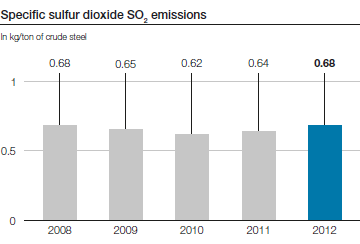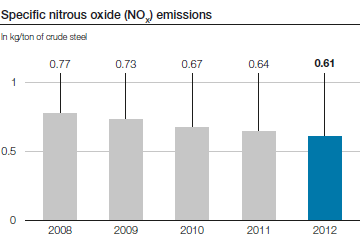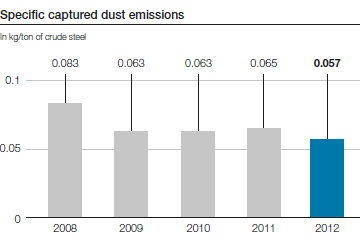The most serious air pollutants are dust, sulfur dioxide (SO2), and nitrous oxide (NOX). Our primary objective is to comply with the statutory threshold limits for all pollutants.
By implementing numerous measures to ensure good air quality, the emissions of the production facilities were significantly reduced. First of all, voestalpine endeavors to prevent emissions to the greatest extent possible by way of process optimization and, secondly, the company aims to reduce the remaining emissions through end-of-pipe measures utilizing state-of-the-art technology.
Monitoring at the Linz site
At the Linz site, two-thirds of the major emissions of the integrated steel mill are being continuously measured, reported online to the local environmental agency, and analyzed to ensure that the threshold limits are complied with.
The other emissions are analyzed by accredited measurement institutes in accordance with the measurement intervals required by law and tested to ensure that the statutory threshold limits are complied with.
Sulfur dioxide (SO2)
During certain processing steps and when utilizing by-products (coke oven gas and blast furnace gas) for energy generation, the sulfur that is introduced into the production process through the raw materials is released as sulfur dioxide (SO2).
As content of sulfur in by-products used varies, the SO2 emissions vary accordingly in the period under review.
Nitrous oxide (NOX)
Nitrous oxides (NOX) are gaseous nitrogen compounds that are generally created during combustion processes; they are also created in the soil through microbiological decomposition processes. At voestalpine, nitrous oxides are created during the production process in various industrial facilities. During the reporting period, voestalpine was able to reduce the emissions of NOX by roughly 20%. This was achieved by way of denitrification systems and improved combustion technologies.
Innovative environmental technologies
In late 2012, a DeNOX system for the denitrification of sintering exhaust gas was put into operation at the Linz site, a unique installation in Europe.
In the future, NOX emissions will be reduced by around 400 tons annually. This measure ensures a long-term improvement of the NOX situation at the Linz site and guarantees that voestalpine will be able to comply with the statutory provisions in the future.
By the early 1990s, a highly efficient wet gas cleaning system (AIR-FINE) for sintering exhaust gas had been installed in addition to the existing dry electrostatic precipitator. In 2007, voestalpine switched to a dry electrostatic precipitator system that can filter out numerous pollutants using additives (e.g., activated carbon). This MEROS system is an innovative dry exhaust gas cleaning system for sintering exhaust gas that redefines state-of-the-art technology. It enables the reduction of heavy metals, dust, SO2, and organic compounds to a minimum.
The exhaust gases that have already been cleaned in the MEROS system are injected into the DeNOX system. The exhaust gas is warmed up in a heat exchanger and is then denitrified in a catalytic unit using ammonia (NH3). Then the gas is routed through the heat exchanger into the chimney; excess heat is recovered and returned to the system process and reused to heat up the exhaust gas from the sintering facility.
Dust
By taking state-of-the-art precautions, voestalpine ensures that dust-laden exhaust gases and emissions that occur during production are captured and routed to a dedusting system. The reasons for the reduction by more than 20% from the 2008 calendar year to the 2009 calendar year included measures taken with regard to the 8m blast furnace group at the Linz site.
Fuel conversion and improved utilization of heat at Uddeholms in Sweden
The Special Steel Division site in Hagfors, Sweden, replaced heavy oil with natural gas, which is more environmentally friendly, thus combining both ecological and economic benefits.
The furnace was rebuilt for the new regenerative combustion technology; this improved both heat utilization and maintenance efforts significantly. By switching to the significantly more environmentally-friendly liquid gas, specific emissions, such as CO2 and NOX, are being reduced and energy efficiency is being optimized.



